SMA EV Charger: your questions, our answers
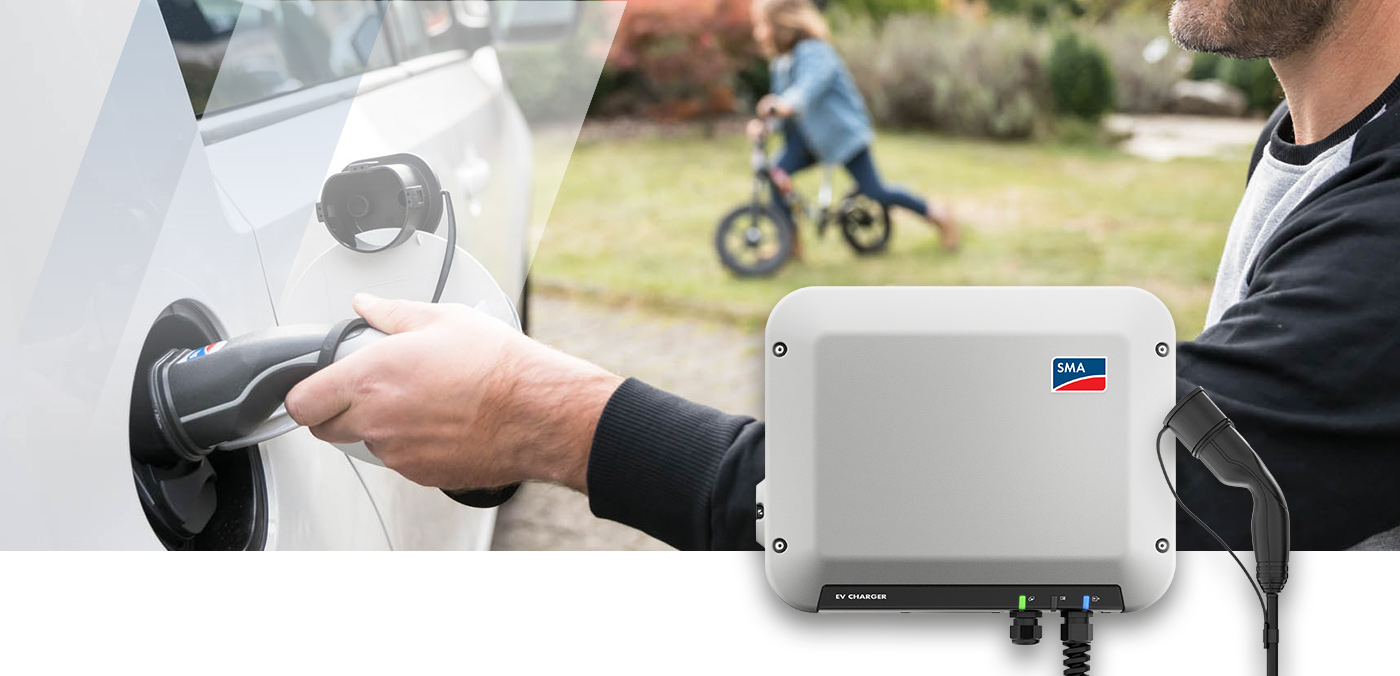
[Update dated June 29, 2022 | Software update 1.02.23.R and longer charging cables] SMA EV Charger ensures that you benefit from more solar power in the tank by converting solar power from your roof directly into climate-neutral range on the road. But do I need my own PV system and the Sunny Home Manager to charge my electric vehicle? From where do I get longer charging cables? How do I prevent unauthorized use of my SMA EV Charger? Here, SMA Charging Solutions Expert Lisa Spangenberg provides answers to your questions.
I don’t have a Sunny Home Manager 2.0. Can I still use SMA EV Charger?
SMA EV Charger was developed for use with the Sunny Home Manager 2.0. This configuration also allows you to use intelligent charging management. However, even without the Sunny Home Manager 2.0, SMA EV Charger can be used as a standard wallbox and easily integrated into a PV system later on.
How do I use SMA EV Charger as a standard wallbox?
When setting up the system, simply deselect the option “operation with grid-connection point meter” (see Figure 1). Note, however, that visualization in the Sunny Portal and SMA Energy app and all the functions that come with SMA Energy System Home are available only in conjunction with the Sunny Home Manager 2.0.
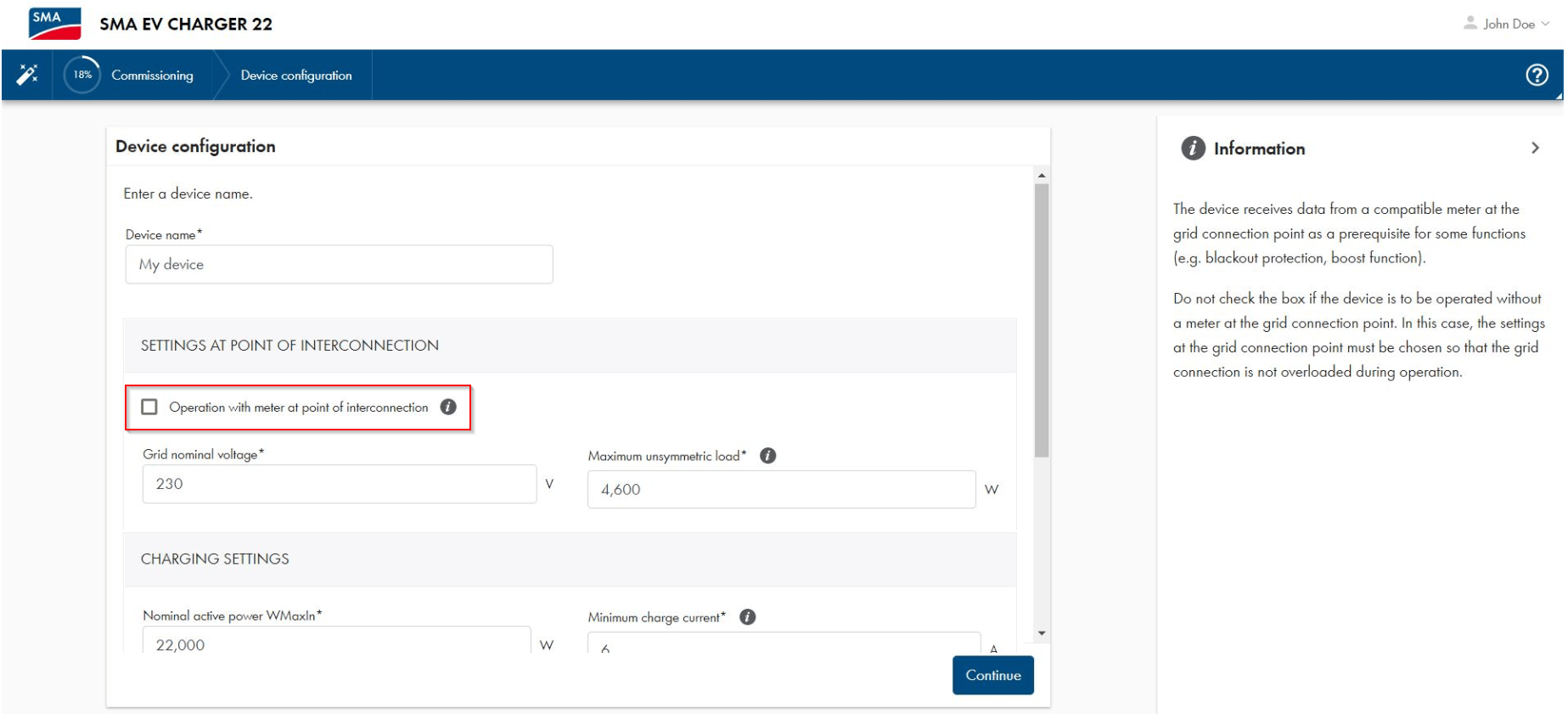
Figure 1: If you want to use SMA EV Charger as a standard wallbox, simply deselect the option “operation with grid-connection point meter” when setting up the system.
Is the previous version – Sunny Home Manager (Bluetooth) – also compatible with SMA EV Charger?
In principle, SMA EV Charger can also be operated in combination with the Sunny Home Manager BT, but with some restrictions: For example, SMA EV Charger does not appear in the device overview in the Sunny Portal; the control steps are much bigger; no events are transported to the system logbook; SMA Smart Connected is not available; visualization and control via the SMA Energy app are not possible. Forecast-based charging then has to be configured indirectly using the parameter settings on the device’s user interface. If you want to make full use of the intelligent charging options, you should thus consider using the Sunny Home Manager 2.0.
Click here for more answers:
(Update) How many SMA EV Charger can I operate with one Sunny Home Manager 2.0?
With software update 1.02.23.R for the SMA EV Charger, up to three SMA EV Chargers are now supported on one Sunny Home Manager 2.0 (≥ 2.08.5.R) in multi-EVS mode. This will allow the SMA EV Chargers to be visualized and controlled via the SMA Energy App.
(Update) The 5 m charging cable supplied as standard is too short for my application. Does SMA also offer longer charging cables?
Charging cables of 7.5 m and 10.0 m in length have been available as options since August 2021. Installers can order the cables as spare parts through the SMA Online Shop and retrofit them to existing systems. System operators should contact their installers directly, as the SMA Online Shop is intended for use by solar power professionals only.
SMA EV Charger has two switch positions, but offers three different charging modes. How can I switch between them?
You can switch between fast charging and optimized charging using the rotary switch on the SMA EV Charger enclosure. Note, however, that you cannot configure fast charging mode via the SMA Energy app. If you set the rotary switch to the optimized switch position, SMA EV Charger will begin PV-optimized charging by default. Alternatively, you can then set a desired charging target via the SMA Energy app.
The documentation contains frequent references to the “slider.” Where can I find this, and what does it do?
You can find the “slider” in the Sunny Portal by choosing load characteristics > optional energy requirements. In optimized charging mode, your electric vehicle will be charged with the minimum share of solar energy for SMA EV Charger. Depending on how your system is configured, for example, you should allow 20% grid-supplied power to ensure that the Sunny Home Manager 2.0 also performs scheduling for small PV systems or can take into account variable weather conditions. Rather than a static value, this figure is more of a target that the Sunny Home Manager 2.0 will aim to achieve throughout the day (see Figure 2).

Figure 2: Depending on how your system is configured, you should allow a certain share of grid-supplied power in optimized charging mode to ensure that the Sunny Home Manager 2.0 also performs scheduling for small PV systems or can take into account variable weather conditions. This can be set using the slider in the Sunny Portal.
I have configured the slider for SMA EV Charger in the Sunny Portal for 100% PV power generation, but the SMA Energy app still shows only a small amount of grid-supplied power. Why is this?
The Sunny Home Manager 2.0 regulates SMA EV Charger at one-minute intervals. Especially when conditions are variable, this may result in a discrepancy with respect to the actual level of PV power generation. So even if you have set 100% power generation, it is still possible that only a small amount of charging power is actually drawn from the utility grid. In addition, planning is done by the Sunny Home Manager 2.0 based on a schedule (hypothesis). Regular changes due to unforeseen events are absolutely normal.
What are the different sources of energy used for charging my vehicle in the different charging modes?
During fast charging, the vehicle is charged with the maximum power that the vehicle and house allow. Any energy source is used here, so the system could potentially be drawing power from the home storage system to charge your vehicle.
During PV-optimized charging, SMA EV Charger charges the vehicle with the energy mix saved in the Sunny Portal (slider). Charging of battery prior to optional loads checkmark decides whether the battery or OPTIONAL load is supplied with the surplus solar power initially. Depending on how the slider is set, energy from the home storage system or utility grid can also be used to charge the vehicle.
During forecast-based charging, surplus solar energy is initially used for achieving the charging target configured in the SMA Energy app. If not enough of this energy is available for achieving the charging target, the home storage system is used. Once the home storage system is used up, the energy is drawn from the utility grid.
Is SMA EV Charger suitable for bidirectional charging? Will a DC charger be available?
SMA EV Charger is designed for unidirectional AC charging of the electric vehicle in accordance with IEC 61851-1. Bidirectional DC charging at home is therefore not possible. This is prevented in particular by regulatory conditions. In addition, the galvanic isolation prescribed by the applicable standards results in high original costs for charging solutions. Vehicle manufacturers are increasingly offering vehicle models with communication in accordance with ISO 15118, thereby potentially enabling bidirectional applications. SMA is monitoring developments in this area with great interest.
Under what conditions can I receive KfW 440 funding for SMA EV Charger?
SMA EV Charger 22 is eligible for funding. When setting up your system, the solar power professional has to limit the device to a charging power of 11 kW (see manufacturer’s declaration the product page download area*). In addition, all the power for charging the electric vehicle has to come from renewable energies. This can be demonstrated by either concluding a green electricity contract (e.g., SMA JOIN) or submitting a self-declaration that the vehicle is charged exclusively using self-generated solar power. Once your request has been approved by the KfW, you have to install your system within nine months and submit the necessary documentation.
My SMA EV Charger does not begin charging until a large amount of surplus power is available. The vehicle is not charged if only a small amount of surplus photovoltaic power is available. Why might this be?
When SMA EV Charger is installed, it is vital that the charging cable supplied is connected as shown below (see Figure 3). If the lines are not connected as shown, single-phase charging cannot start. Three-phase charging begins only when a large amount of surplus power is available. The charging cable must be installed only by an electrically qualified person.
(Update) I have restricted SMA EV Charger to 11 kW. Why doesn’t it perform single-phase charging with more than 3.5 kW now?
This is because the maximum charging power of the SMA EV Charger is currently restricted based on current. When restricted to 11 kW, the maximum charging current of the device is 16 A. To prevent the device’s fuse protection level being exceeded, single-phase charging of the vehicle will not exceed 3.5 kW either.
With software update 1.02.23.R, single-phase charging at up to 7.4 kW is possible even if the SMA EV Charger is restricted to 11 kW, provided that the electrical installation permits (e.g., line cross-section, fuse protection). The fuse protection of the electric circuit for the SMA EV Charger is the determining factor in this case (see AC current restriction parameter).
I want to charge my vehicle up to a maximum of 80% SOC (state of charge). How can I set this?
The SoC of the vehicle battery is not transmitted to the vehicle via PWM communication (pulse width modulation) as standard during charging in accordance with IEC 61851-1. The SMA EV Charger therefore has no current information on the state of charge of the vehicle battery and cannot use this information to optimize energy management.
Can the charger read the state of charge (SOC) of the connected vehicle via powerline communication (PLC)?
No, because there is no standard transmission of the SoC via PWM communication (pulse width modulation) from the vehicle to the charging station.
Which conditions have to be fulfilled so that the integrated boost function can be used?
The integrated boost function enables single-phase charging with up to 7.4 kW. The integrated symmetry feature ensures that the country-specific unbalanced load limit (4.6 kW in Germany) is adhered to at all times. This is possible, however, only when a single-phase (battery) inverter is connected in the same phase as SMA EV Charger. A three-phase inverter feeding into the grid is not sufficient here. Alternatively, large loads can be connected in the other two phases. The boost function itself does not need to be activated. As soon as solar power is available and the necessary conditions have been fulfilled, power from the utility grid and solar power are automatically combined for faster charging.
SMA EV Charger ensures greater safety for my house connection. Which parameter can be used as a reference here?
Thanks to power outage protection, SMA EV Charger can be easily integrated into an existing energy system at any time. Optimal utilization of the available connection capacity means that the house connection does not need to be expanded. When multiple loads are operated in parallel, SMA EV Charger automatically and dynamically reduces the charging power of the electric vehicle before a critical overload is reached, which prevents fuses from blowing. When the solar power professional sets up the system, the nominal current of the selective main miniature circuit breaker and not the SMA EV Charger fuse protection should be specified under “nominal current of the point of interconnection” (see Figure 4).
I drive a Renault ZOE. What minimum charging current do I have to set?
As standard, the minimum charging current is set to 6 A (in accordance with IEC 61851-1) (see Figure 5). Depending on the vehicle connected, this may need to be changed. Due to its internal charging electronics, the Renault ZOE charges without any issues only from a charging current of 10 A. Ask your vehicle manufacturer about the minimum charging current for your vehicle. Any change to this value also affects the start of charging and the switching threshold of automatic phase-switching.
People always think that the electric vehicle’s on-board charger is destroyed during automatic phase-switching. How does SMA EV Charger deal with this?
Automatic phase-switching by SMA EV Charger enables maximum utilization of self-generated solar power. This poses no danger to the electric vehicle’s on-board charger because there is a 120-second changeover pause between single- and three-phase charging – in other words, active single-phase charging is stopped and three-phase charging is activated after a short wait (see Figure 6). An integrated hysteresis prevents constant switching between the phases.
SMA phase-switching is like a manual interruption in the charging process and causes no vehicle damage when the equipment is properly installed and configured (relay switchover time).
(Update) My SMA EV Charger has been installed at a location that can also be accessed by third parties. How can I prevent possible charging by unauthorized third parties?
With SMA EV Charger software update 1.02.23.R, it is possible to approve each charging operation via the SMA Energy App (Android/iOS ≥ 1.12.X.R). To do this, simply enable the “Charging release via app” parameter once in the commissioning wizard or later via your device’s user interface. After that, each charging process will need to be approved manually via the SMA Energy App before it can begin after you plug in your electric vehicle. Charging approval will apply to the entire charging process until you unplug your electric vehicle. The charging approval option is available to all persons registered as users in the Sunny Portal system as well as for all SMA EV Chargers already installed.
If no digital signal source (e.g., ripple control receiver, remote terminal unit) is connected, there is the alternative option of using the digital inputs of the SMA EV Charger to connect an external key switch. This means that an external key switch can be connected to the fast stop and configured during commissioning via Grid management services > Active power control. This ensures that charging will not start until it has been approved.
Configure active power control only if a digital signal source is connected to the digital inputs of the SMA EV Charger. Without this, the SMA EV Charger will not charge the vehicle because it is still waiting for charging approval via the digital inputs. Activation of the function can be found in the log book of the Sunny Portal as the “Active power limitation / Fast stop active” message.
Does SMA EV Charger allow me to settle charging costs via my employer or tax office?
SMA EV Charger is implemented with an MID-compliant energy meter, but is not suitable for billing purposes (e.g., settlement via your employer or tax office) due to its systemic integration into the energy system. See terms of use for the Sunny Portal, Section VII.
I use SMA EV Charger 22. When I insert the charging cable into our ID.3 but do not want charging to start immediately, charging does not start at all. The wallbox seems to “fall asleep” in the process.
This is a known issue with first-generation ID.3 models which can only be solved by a software update of the vehicle. Within the framework of our in-series field tests with various vehicle models, we observed that the vehicles no longer “fall asleep”, even during optimized charging, following the extensive software update 2.1.
During PV surplus charging, the ID.3 “falls asleep” when charging power is temporarily unavailable (e.g., due to a passing cloud or if a washing machine is running). The fault seems to lie with VW here. Is it worth talking to VW about this? According to the VW customer service team, everything is working as it should.
During our in-series field tests, we noticed that the problem with updating the vehicle to version 2.1 has been fixed.
Why is SMA EV Charger more expensive than other wallboxes?
Charging with the SMA EV Charger is not only about charging the electric vehicle, but rather the fact that the solar power generated from your system can be used intelligently for this purpose. E-mobility is only sustainable when the charging current comes from renewable energy sources. Thus, it is the intelligence of the SMA EV Charger that makes the device slightly more expensive than standard wallboxes at first glance. However, it enables you to make the best possible use of your valuable solar power through intelligent functions such as automatic phase-switching. As a result, you can charge sustainably at an unbeatable low cost. Using the flexible charging modes, you can decide for yourself anytime whether you want your car to be ready to go quickly or whether you simply want to charge it in a particularly sustainable and affordable way.
Does the charger cause radio interference, potentially causing problems with amateur radio operators or the German Federal Network Agency?
SMA EV Charger meets the normative requirements for radio systems. The relevant EU Declaration of Conformity can be found in the download area of our product page.
Why is the charger not in the car?
The charger itself (AC on-board charger) is integrated in the vehicle. A wallbox / charging station is required to ensure compliance with the safety functions and control the charging process.
*How to access the document in the SMA download area: 1. Category: Charging Solutions for E-Mobility, 2. Product Family: SMA EV Charger, 3. Document Type: Certificate > Manufacturer’s declaration for limiting the maximum charging power with the EV Charger
Learn more about SMA EV Charger?
In this post, we outline the benefits of the intelligent charging solution in combination with the SMA Energy System Home.
Click here to go to the charging solutions for e-mobility.

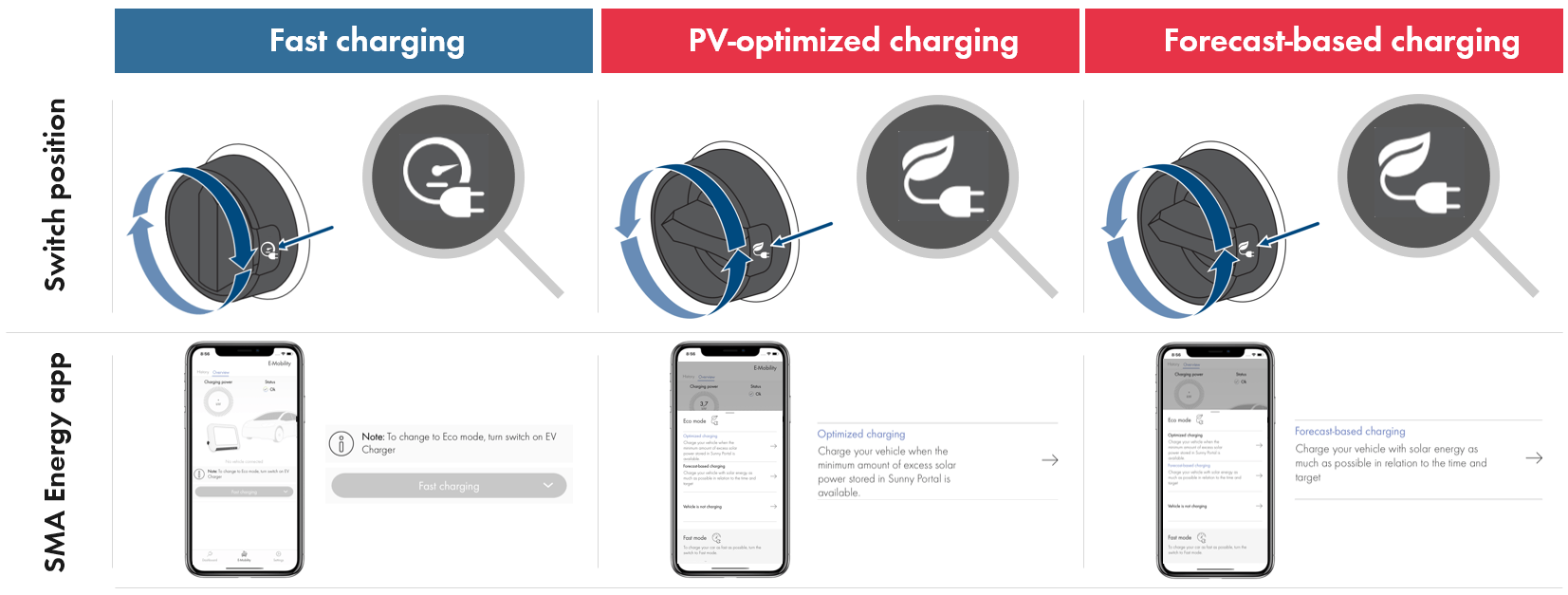
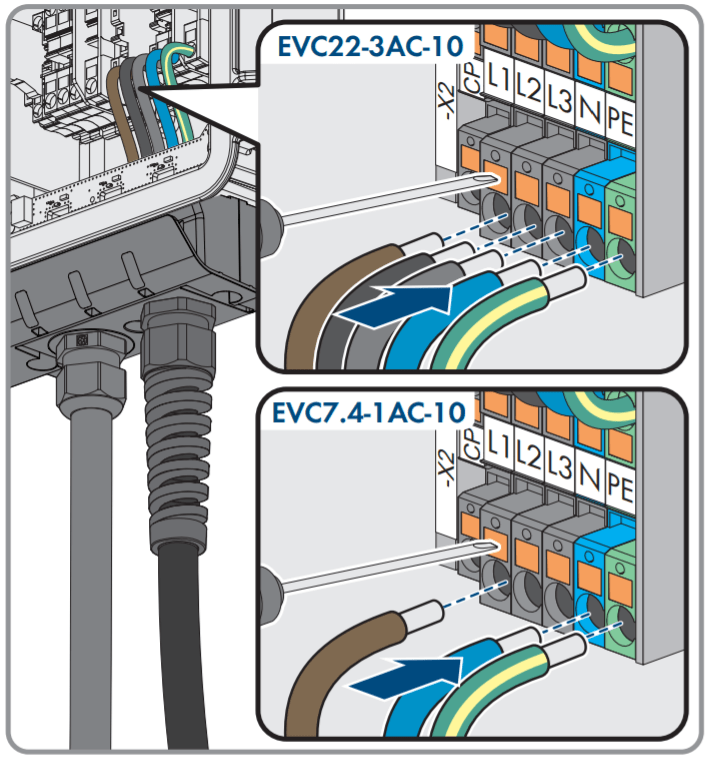
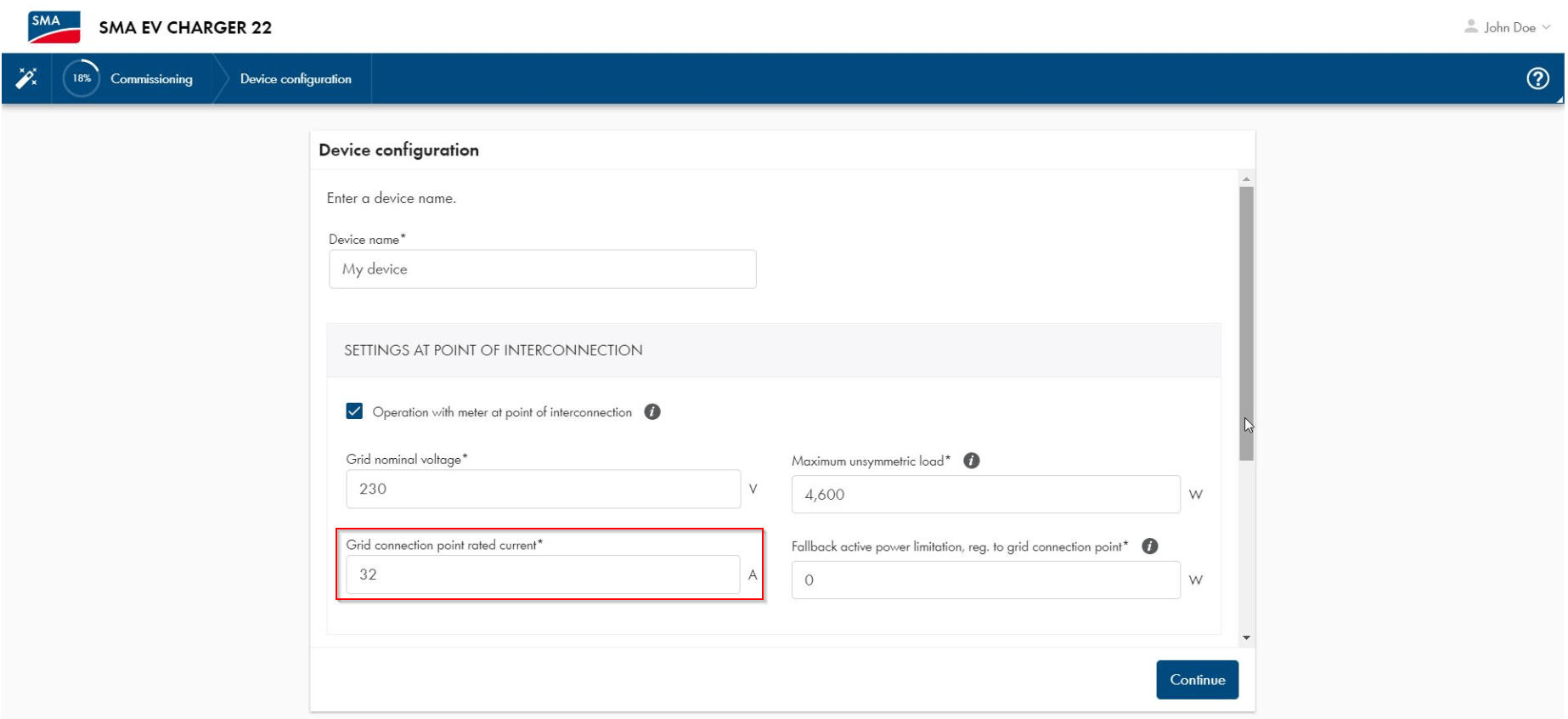
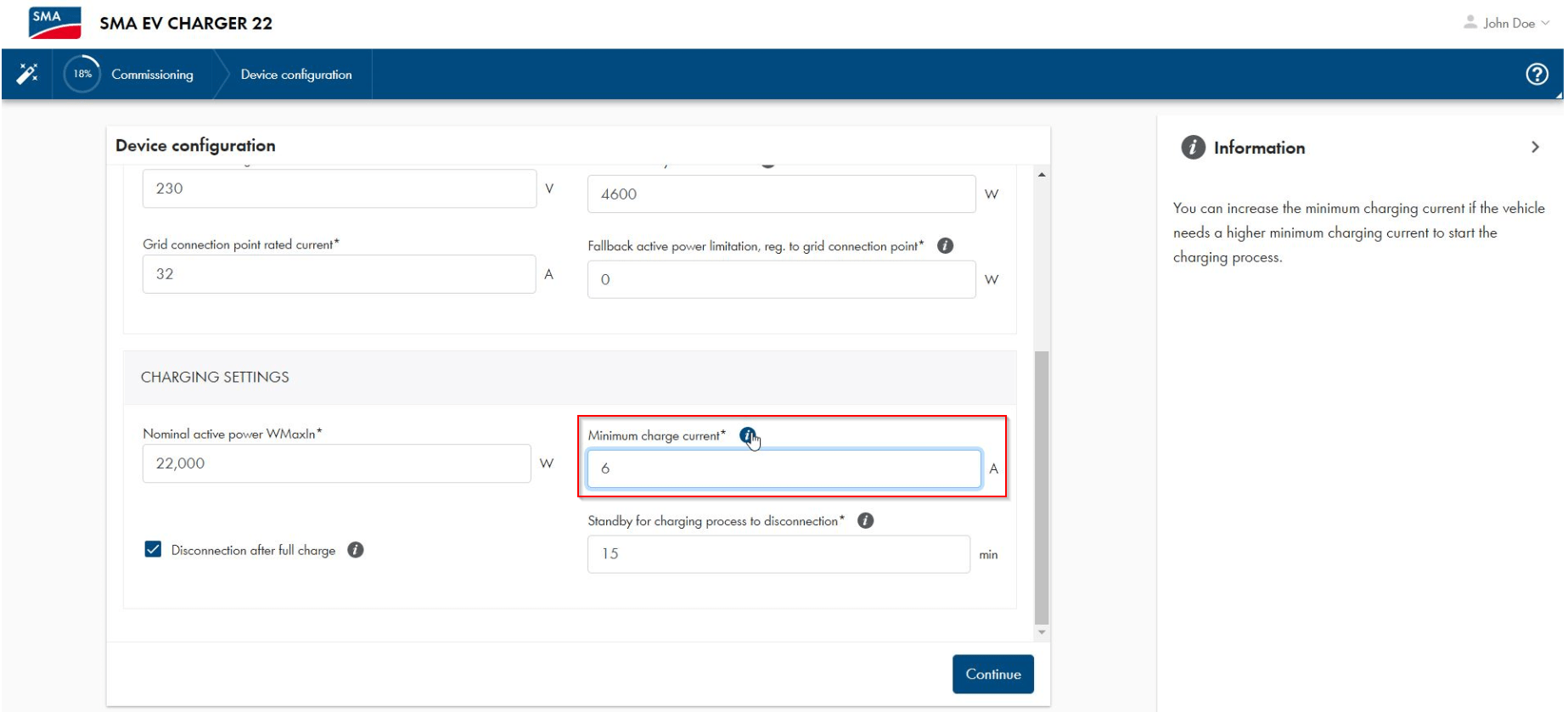
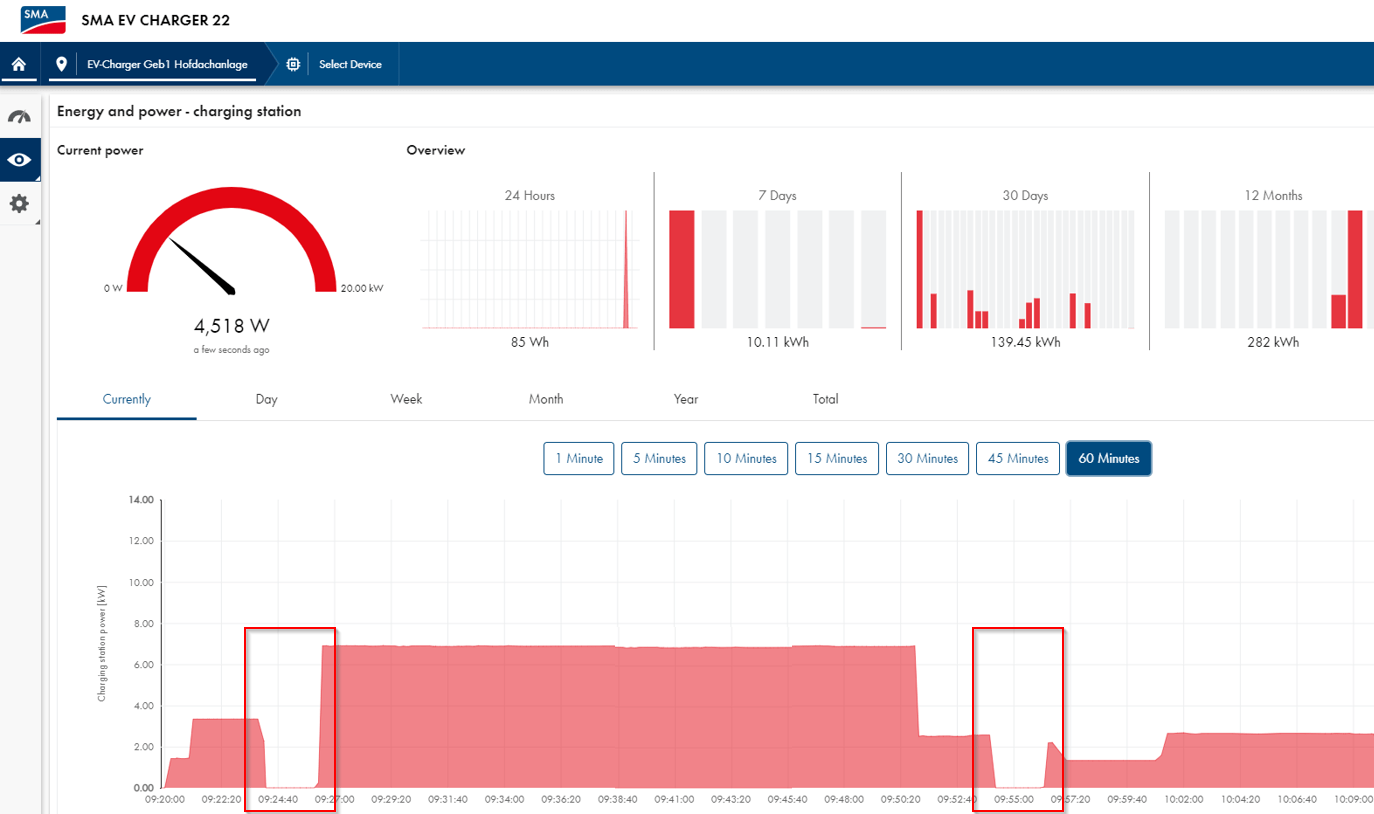
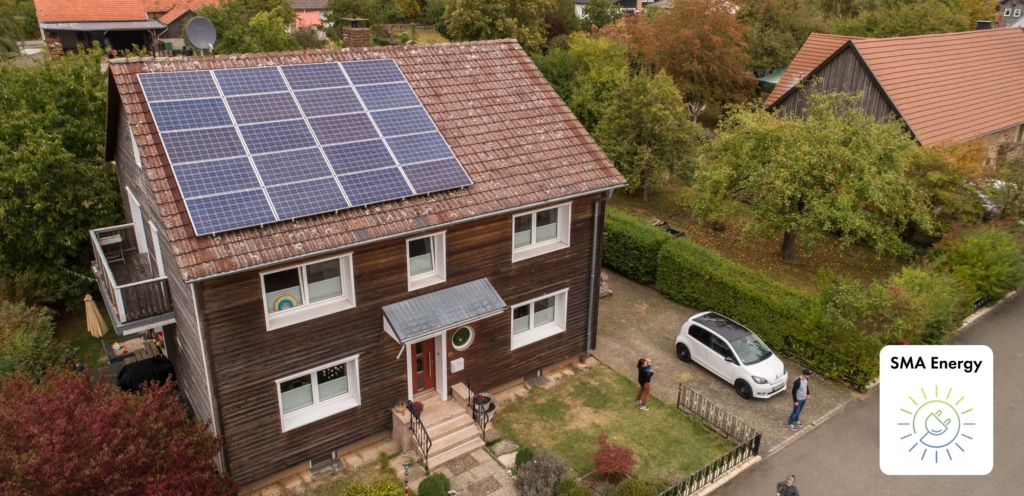
Why does the ev charger not have an option to allow for “100%” stored battery power charging only? I think most users who have a battery and have the vehicle out during the day would like this option.
Hello Jarrod,
maximum utilisation of the battery is possible if the charging modes are set accordingly or manual control is used. Please contact the SMA Service directly for further system details.
Sunny regards
Christiane
I have a 12KW set of panels feeding STP10 connected via home manager 2 tn SMA EVC22 Charger.
I can not seem to get my car (Ionic 5) to charge with excess PV energy at least not with any sort of reliability.
I have played with the slider -100% PV Surplus would be the obvious setting but have tried 30/50 etc. Does not change things as far as I can tell.
Even I have upward of 5Kw of excess the charger will not charge. If it does it invariably ramps quickly to 11.4Kw taking in grid electricty it will not just send excess. Meanign after 2 hours the battery may be full and excess PV after that wasted.
I have spoke with the installer who seem unable to fix. I have contacted SMA Service over a week ago and aside from an automated message and case number have had no reply.
This is getting very frustrating. Afer many months I essentially have a non smart SMA Charger that will either not charge on PV Surplus or charge at 11.4kw (more than my PV capaicity). It does not as it should track excess and use it.
SMA’s Service website says contact the installer for most things. The installer can’t fix. SMA Does not reply. I don’t have what I expected.
Please fix it in a reaonable time frame.
Hello Alex,
Sorry to hear that you are still waiting for a feedback from our SMA Service.
Due to a very high number of inquiries coming in at the moment, there is a delay in getting back in time.
As you have already opened cases at the SMA Service, please get back to us in this matter using this channel.
For a feedback, you may open your case and leave a message for our Service team.
It is also helpful to open only one case for one question.
Thanks for your understanding!
Sunny regards
Christiane
Wij hebben 12 zonnepanelen die 7 jaar werken. Maar nu nu doet de omvormer vreemd regelmatig staat de bovensmeter in het display op nul en de omvormer eevreemd geluid, ook tijdens de tijd dat de wasmachine draait levert de omvormer geen stroom en word de stroom van het net gehaald. Ook brand er regelmatig een rood lampje dat de strroom niet geleverd kan worden aan het net en darover heb ik contact met de net behaarder enxesis.
Kunt u mij helpen?
Hallo meneer Hunse,
Voor verdere systeeminformatie kunt u rechtstreeks contact opnemen met SMA Service, dank u.
Met vriendelijke groet
C. Keim
Is it possible to set up lower charging rate? It seems it’s only possible to charge at full or solar power optimized charging speed?
Hello Frederik,
Please get back to our SMA Service for further support, thank you.
We need more details in your case.
Sunny regards
Christiane
Good observation Frederik Verdonck. I cannot do this. My wish is to not have EV charging interrupted by a cloud, microwave or toaster. But to always run at minimum 6A and thus use as much solar power as possible on days with variable solar generation. Instead I lose energy every time the charger stops and then later on starts again.
Hello Ulf,
Please get back to our SMA Service for further help.
Sunny regards
Christiane
That is also what I would like, as now every passing cloud adds to flood of stop/start push messages to MercedesMe app to all family members that drive the car and have the app. Also start of charging is heavy/complex/long operation in the expensive cars, due to important internal rituals to prepare (battery cooling pumps start, relays on, etc.), so the car is unhappy with too many stop/starts due to every passing cloud and goes into error/red mode blocking the charger after some time. To charge with stability, several extra parameters are needed in EV charger:
– MinimumChargeDuration, in minutes (the minimum duration charging shall continue uninterrupted with minimum allowed current, typically 6A, if it was started, even if solar generation goes below minimum), the default 10 minutes.
– MinimumPVsurplusDurationToStartCharging, in minutes (the minimum duration for enough of sustained PV surplus shall be present in order to start charging), the default 10 minutes. This will ensure charging will not start if there is no stable enough generation and the risk is too high stop will be needed too soon
-ExtraPVsurplusCurrentToStartCharging, in A (the minimum extra current above minimum charging current). If this is 4A, and minimum default is 6A, then the charging shall only start when export to grid exceeds 10A for the duration set above (on highest loaded phase in case of 3 phase charging), default 1A.
-KeepExtraPVsurplusToGrid, in A (the grid export current the charger shall try to keep while charging), for example, if this parameter is 2A, the solar surplus is 12A, then the charger will use 10A for charging, keeping 2A for grid export to avoid grid purchases for any unpredicted loads like refrigerator on. Default – 0. If negative, then this shall indicate how much of grid current will be added to solar current, for example if -2A, solar generation is 12A, then 14A shall be used for charging, 12A from solar and 2A from grid. Highest loaded phase shall be used for measurement in 3phase mode.
-Disable1phaseCharging Yes/No (for countries with per phase grid accounting and Tripower inverters, 1 phase charging has no commercial logic to use it), default No.
Just these 5 parameters would solve all the problems and address different wishes/scenarios. They will have no impact by default, but Ulf could set MinimumChargeTime to 120 minutes, for example, which means that if charging already started, it will not stop at least 2 hours, charging at minimum even if generation-usage gets below minimum charge current.
Hello Almantas,
Thanks for your feedback and your suggestions.
At the moment, no updates or changes are planned.
Sunny regards
Christiane
Is it possible to set up a start charging time and a end time?
I can only find options to set up a finish time. it would be very interesting so low cost tariff rates at night could be used.
Hello Manuel,
Electricity tariffs can be stored in the plant properties in Sunny Portal.
These are then taken into account during forecast-based charging.
Sunny regards
Christiane
Can the SMA charger’s smart functions operate in an off-grid system? Can it be used to optimise EV charging based on PV generation and SOC of the house batteries?
ie can the EV charging be used as a dumpload when the house batteries are full?
Hello L Roberts,
Please contact our Service via our SMA Online Service Center.
We need more technical information for further support.
Sunny regards
Christiane
Any news on the update to support >1 EV Charger? It’s been promised! My EV is waiting…
„The Sunny Home Manager 2.0 currently supports one SMA EV Charger. We expect that it will be possible to connect up to three SMA EV Charger to one Sunny Home Manager 2.0 by the middle of the year. This configuration for home use will then also be supported by the SMA Energy app.“
Hello Thomas,
The use of three SMA EV Chargers on one Sunny Home Manager 2.0 including control via the SMA Energy App is – presumably – planned until the end of the year.
Sunny regards
Christiane
Very pertinent observations that have a significant impact for the correct management of energy flows and the related costs, the proposed solution is very reasonable. What is SMA’s opinion on this aspect? Will a software update be developed?
Hello Maurizio,
Can you please get back with some more detailed information on your request?
Best regards
Christiane
Is there any feedback from SMA about this important aspect? Is it the case for Tripower smart energy series as well?
Hello Ahmet,
please contact our technical staff of the Online Service Center or your installer for more information about the flow of energy of the Sunny Tripower Smart Energy inverters.
Sunny regards!
I would like to understand what is the rationale of single phase charging in 3 phase home and PV system. All SMA Tripower 3 phase PV inverters generate equally into all 3 phases, there is no way to adjust generation per phase based on Home Manager 2.0 per phase measurements, in order to compensate inequalities in the L1, L2, L3 currents. Therefore, energy is purchased at full grid cost for load on L1, for example, and at the same time generated into the grid via L2, L3. In LT and many other countries, the utility grid counter measures each phase separately, and it is assumed that grid buys L2, L3 surplus while grid sells the gap to L1. This transfer between phases cost about 50% (Consumption tariff – Feed-in tariff). Unfortunately, I did not found how to setup Sunny Portal (SP) to account this properly and show at same time consumption and generation in SP/mobile app – it always sums all 3 phases, and that is misleading. If its -5kW on L1, and +2kW on L2, and +3kW on L3 at grid connection point, SP counters show zero generation/zero consumption while actually it is 5kW consumption and 5kW feed in at same time. Therefore all the statistics in the SP are not correct. Even more cost will be generated by this EV charging device if it assumes energy transfer between phases from grid is for free, which is surely at high cost in many countries. Single phase charging then shall be always turned off in countries with per-phase accounting, and Grid feed-in/Purchased electricity bar must be shown partially red, partially green, with 2 numbers (5kW in red and 5kW in green), with some SP setting like “Per phase grid accounting” set to ON. Then additional loads shall be activated only if all 3 phases will remain in surplus state. I hope support for “per phase accounting” countries will be added to SP soon. It also would be very nice check box “Cover consumption on other phase(s) before feeding into the grid”, if 3 phase Sunny Island is used in the home, so instead of feed-in and consumption at the same time the surplus of energy could be taken from one phase and given to another phase, so that grid feed-in starts only when there is no any electricity purchase from the grid via any phase.